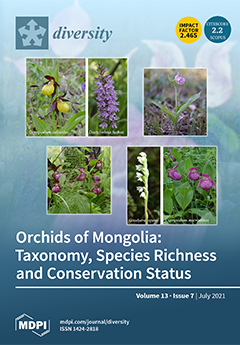Ocean acidification has been broadly recognised to have effects on the structure and functioning of marine benthic communities. The selection of tolerant or vulnerable species can also occur during settlement phases, especially for calcifying organisms which are more vulnerable to low pH–high pCO
[...] Read more.
Ocean acidification has been broadly recognised to have effects on the structure and functioning of marine benthic communities. The selection of tolerant or vulnerable species can also occur during settlement phases, especially for calcifying organisms which are more vulnerable to low pH–high pCO
2 conditions. Here, we use three natural CO
2 vents (Castello Aragonese north and south sides, and Vullatura, Ischia, Italy) to assess the effect of a decrease of seawater pH on the settlement of Mollusca in
Posidonia oceanica meadows, and to test the possible buffering effect provided by the seagrass. Artificial collectors were installed and collected after 33 days, during April–May 2019, in three different microhabitats within the meadow (canopy, bottom/rhizome level, and dead matte without plant cover), following a pH decreasing gradient from an extremely low pH zone (pH < 7.4), to ambient pH conditions (pH = 8.10). A total of 4659 specimens of Mollusca, belonging to 57 different taxa, were collected. The number of taxa was lower in low and extremely low pH conditions. Reduced mollusc assemblages were reported at the acidified stations, where few taxa accounted for a high number of individuals. Multivariate analyses revealed significant differences in mollusc assemblages among pH conditions, microhabitat, and the interaction of these two factors.
Acanthocardia echinata,
Alvania lineata,
Alvania sp. juv,
Eatonina fulgida,
Hiatella arctica,
Mytilys galloprovincialis,
Musculus subpictus,
Phorcus sp. juv, and
Rissoa variabilis were the species mostly found in low and extremely low pH stations, and were all relatively robust to acidified conditions. Samples placed on the dead matte under acidified conditions at the Vullatura vent showed lower diversity and abundances if compared to canopy and bottom/rhizome samples, suggesting a possible buffering role of the
Posidonia on mollusc settlement. Our study provides new evidence of shifts in marine benthic communities due to ocean acidification and evidence of how
P. oceanica meadows could mitigate its effects on associated biota in light of future climate change.
Full article





